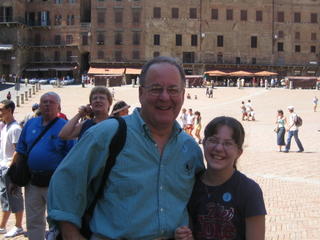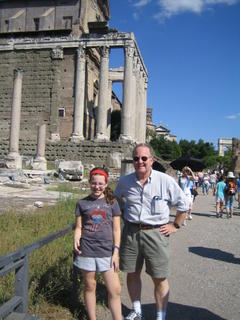


Pictured here, MMC and daughter at the Roman Forum (and Siena), August, 2005. 2500 years of history, layer upon layer, in the footsteps of the Emperors, the foundations, both literally and figuratively, of Western civilization, and all I can think about while here is, 'My god, its, 95 degrees and what I wouldn't give for a cool Lime Squishy and a dunk in a pool.' Of course, there was no pool available. OK, so creature-comfort comes before my appreciation of high culture and the history of Wesern Civ . I'm spoiled. I've become a member of the air conditioned class. (Thanks Sandra for the Class designation)
For all those awaiting more philosphical insight: Here is what I am thinking today: Why have human civilizations throughout history so much depended upon barbarism, terror, and violence, to sustain themselves? Take, for example the Roman gladiatorial system and the theme of brutal circuses and free bread. It wasn't just that the participants must have been brutalized, but the whole of Roman society must have internalized a kind of normalized violence and cruelty. Oh Oh! (Sound Familiar?) Fast forward 2000 years: Q: What's changed in contemporary, advanced industrial societies? How much have we progressed? A: Air conditioning.
Today, in our contemporary culture, we have plenty of spectator viloence, although much formerly overt public violence has been hidden from view and is perpetrated far from our eyes (e.g Iraq and Afganistan, Darfour, etc.). At home, sadistic cuelty now takes the place of gladiatorial mahem in the cultural arena; to wit "reality" TV shows (which are, of course aything BUT, real) and the fine achievments on offer, from FOX, like "the Apprentice."
In any case, we saw Rome, Venice, Siena, Pisa, and Florence. Took in all the sites--including the Doge's palace in Venice. Lots of old buildings and old culture. And old illustratrions of the connections between culture, politics, economics and power. I really liked the Doge's palace, in Venice, because among other things, it illustrated perfectly, the early inseparability of church, the organized military violence of the state, and (Catholic) ideology. (The ideology was of course, more beautifully portrayed by impressive painters, than today's global Coke and Rebok ads). The 'Bridge of Sighs' runs directly from the Doge's palace (the seat of political and merchant economic power) to the prison and torture rooms. So it must have been pretty clear to 17th c Venetians who held the power and to what use such power was directed. Church, state,
military----all within a few hundred yards of one another. All wrapped up in one palace-sized complex of state power. As I mentioned to H, it would be likehaving the Capitol building in Washington DC, the federal prisons, and the U.S. Army all connected by a convenient catwalk.
Ummmm, maybe things haven't changed that much, after all?? Except for, of course, the air conditioning.

